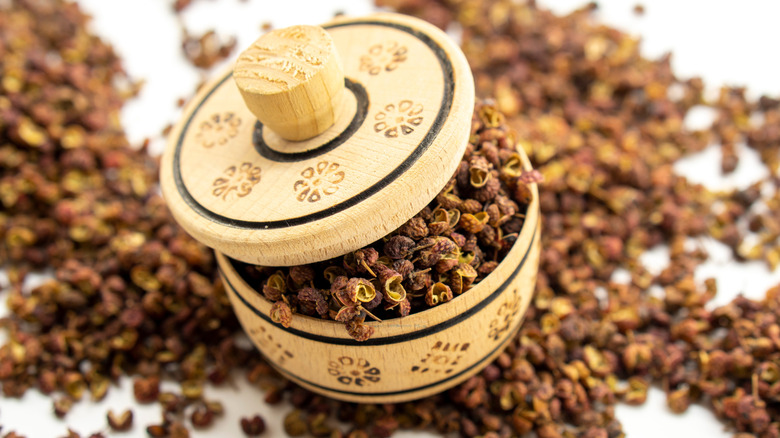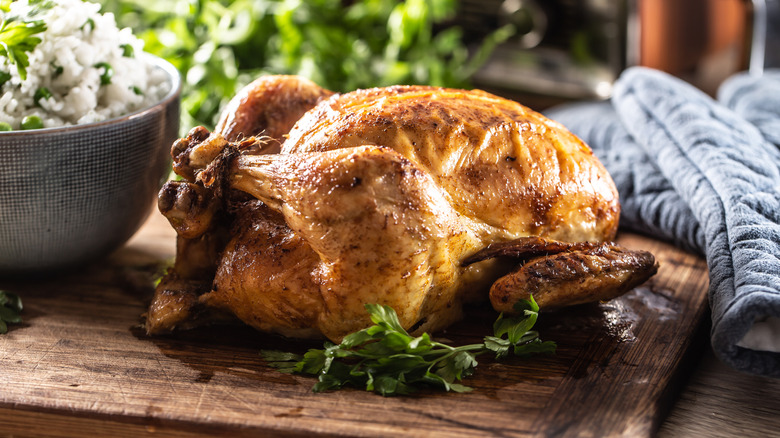The Flavor-Packed Pepper Gordon Ramsay Uses To Transform Roast Chicken
We may receive a commission on purchases made from links.
A perfectly cooked whole roast chicken elevates an everyday piece of poultry to the centerpiece of a fantastic meal. A basic, foolproof roast chicken recipe involves liberally coating garlic butter under and over the skin. But a few simple steps can upgrade that basic chicken — and of course chef Gordon Ramsay has a creative, flavor-forward solution: Sichuan pepper, and plenty of it.
In Ramsay's second MasterClass, "Restaurant Recipes at Home," he walks viewers step-by-step through his easy Sichuan (or Szechuan) roast chicken. In the video, he ensures you avoid the mistakes many people make when roasting chicken. You learn to properly truss the bird, bring it to room temperature before putting it in the oven, and more. But the most intriguing moment comes when Ramsay seasons his chicken. Where oil or butter, then garlic, lemon, salt, and pepper are probably the most common treatments, Ramsay takes things up a notch with an egg wash to get his seasonings to stick. Then it's time for the Sichuan pepper.
What is Sichuan pepper?
If you haven't heard of Sichuan peppercorns before, you might think they're spicy, like crushed red pepper or Thai chilis. The fact is, they're not. They're also not pepper, though like black or white pepper, they are berries. Where black peppercorns are dried fruit from a flowering vine (Piper nigrum), the Sichuan "peppercorns" come from the Chinese prickly ash shrub (Zanthoxylum simulans). The fruit is sometimes also called Chinese prickly ash. They are hand-harvested amongst thorny branches and sun dried. Though they are fruits, as they dry, they resemble blossoms.
Considered an anchor spice for Sichuan cooking, there are two types: red and green. The former is the most commonly found on store shelves and is aromatic and earthy, with hints of lemon. The green version is more floral and relatively rare. Both create a sort of electric tingling on the tongue (The green tingles and numbs more). In Sichuan cooking the peppercorns are used to balance spicy flavors, as the tingling, numbing effect allows spicy peppers to feel more flavorful. Cooks believe that the peppercorn's special properties make your palate more sensitive to other flavors, allowing you to better enjoy the complexity of Sichuan cooking. You can pick up bags at Asian grocery stores, or order both the red and green Sichuan peppers from Natruen.
Ramsay's Sichuan pepper roast chicken upgrade
Gordon Ramsay keeps the seasonings simple, but the results are tantalizingly original. After he's stuffed the bird, he whisks up a fresh egg. Using egg instead of butter to coat the chicken has multiple functions: It helps the seasonings stick to the skin, and it browns the skin beautifully and evenly. It's also an effective non-dairy option, if that's important for your guests. For Ramsay, investing time up front to properly dress, truss, and season a whole chicken is key to getting the perfect roast bird. "Trust me, it'll come back tenfold," he says in his MasterClass video.
Once your chicken is fully coated with the egg wash, sprinkle ground Sichuan pepper (Ramsay appears to use the green version) and salt across the top and sides of the bird. Pull the legs and wings out to get in all the nooks and crannies, and truss them when you're done.
The result is an elegant, restaurant-quality interpretation of classic roast chicken. If, after trying this dish, you find Sichuan pepper isn't your thing, there is a wide variety of other intriguing aromatic spices with which you can doll up your bird, taking the flavor profile beyond simple salt and pepper. You can add cinnamon to your roast chicken dish to give it a Moroccan-inspired upgrade. Consider a barbecue spice rub, or look to Thanksgiving turkey recipes for savory rubs that emphasize basil, sage, thyme, and lemon.


